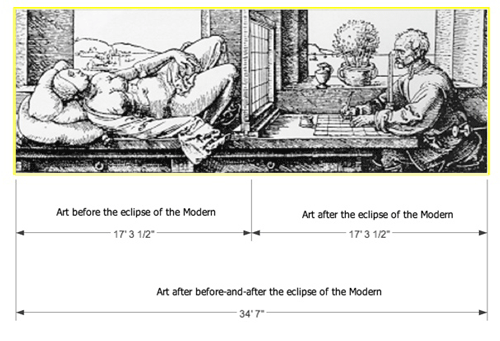February 13, 2007
Art After Before and After

Apropos to the previous post, I remember a story from a friend concerning a studio visit by Paul McCarthy. She was attending a prestigious post grad studio program. She was making sculpture in a serious vein, some people might call it too old school, too modern for our postmodern times. So I was keen to hear what Papa Smurf had to say during his visit. Her report: he said that perhaps she should install a video camera and record herself making her artwork.
She was irritated by his response, every artist who has been an art student knows the feeling. But I thought that Mr. McCarthy was rather gentle and generous to her... and most of all, his recommendation was powerful. He was advising her to include a self conscious dimension to her practice and his strategy was simple, direct and not unfriendly to her current formalist language.
In my version of recent art history, I like to paint the turn from the modern to the postmodern in this way:
In short, this is a description of how the modern became the postmodern in recent art history. Here are a few points to pin a few ideas together:It is important to be able to define what it is to be modern. (It is amazing to me how many people in either the art or architecture worlds can't do this!) Here's my definition: To be modern is to reconcile the life you are lilving with the things you are making. This perspective is most certainly a reflection of my architecture undergraduate degree. The general view of the emergence of the modern in architecture is one of the disruption of the canon by rapidly developing modern technology. New building materials and techniques required an attempt to reconfigure a classical canon into a new (contemporary) one. Over time, efforts continued to fail as new innovations continued to disrupt any attempts to craft a stable narrative.
There are many other voices and narratives (one of the points of Danto's speech, as I uderstand it), but I tend to think of the modern project generally as a reach for transcendance, in blunt terms: to attempt to touch G-d through material means.
There was a crisis at the end of the fifties. Young artists like baby Warhol, baby Rauschenberg, Baby whoever-was-destined-to-contribute-to-Pop Art... they looked at the Rothkos, the DeKoonings and other greats and realized that they weren't going to touch G-d any better than the grizzled masters. So they took the Oedipal turn and flipped the paradigm:
Instead of touching G-d through material means, they endevored to touch everyday life through conceptual means.
This would include baby McCarthy too, even if this was ten years after the turn. His brilliance was to shift art from the world outside to his world inside. And speaking of insides, here is an aside: it is interesting to note -but not to linger on the fact- that he is a Jack-Mormon:
Raised in the Mormon faith and culture, McCarthy insists, "I don't think it was different from any other small community in America. Was it sexually repressed? Probably not much more than other towns in America in the '50s... I kept the issue of the Mormon Church out of my art because it was too much a way of pinpointing (my background) as opposed to what I think about issues of conditioning and consumerism in America."I went to high school in Las Vegas, where there lives a remarkable population of Jack-Mormons, great people, interesting and lots of fun.
*
*
Moving along, nothing to see here, people.
*
*
I don't completely believe in the end of history and that the universalization of Western liberal democracy as the final form of human government would necessarily result in an eternal recurrence to hippy 60's a.k.a. progressive pop cultural philosophy. Every time the spring of culture has cyclically renewed itself recently, it has reinterpreted 60's pop culture in one way or the other. I'm reaching my limit on my ability to reappreciate the 60's. Pop culture may be a result of Western liberal democracy but it should not, it cannot be the only result, the fiinal form. In other words, the final form of human government should be tested by the capability to inspire endless forms of cultural production.
So the question is: can there be another chapter to art after the 60's popped? How can we move on?* Or are we condemned to dutifully scribe footnotes and expand pop culture's bibliography? The addition of the concept of zero to the canon of mathematics was a true revolution, so too was the invention of negative numbers. Go Coprenicus, let Galileo damn the church. Every time humanity comes up to a wall conceptually, we pull a rabbit out of our hat and reinvent the game. So too was the turn from the modern to the postmodern a brilliant moment, incredible it was.
Can we pull the rabbit out of our hat again? Can we be Jack-postmodernists or are we yet too pious to raise a ruckus anymore?
*(I'll let the illustration above suggest my answer.)
Posted by Dennis at February 13, 2007 10:42 AM
Leave a comment